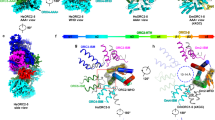Abstract
In higher eukaryotes mechanism of DNA replication origin recognition and binding by origin recognition complex (ORC) is still unknown. Origin transfer studies have shown that origin sites are genetically determined, containing functionally interchangeable modules. One of such modules from the human lamin B2 origin of replication has the ability to adopt unorthodox structure partly composed of intramolecular triplex. Sequences involved in triplex formation coincide with ORC binding sites both in vitro and in vivo. To explore potential significance of unorthodox DNA structures in origin recognition by ORC, we tested DNA binding properties of human ORC subunit 4 (HsOrc4) which has independent DNA binding activity in vitro and similar binding characteristics as ORC holocomplex. Our results demonstrated that DNA binding activity of HsOrc4 depends on length and structure of DNA with triplex being the protein’s preferred binding target. Such feature could play part in origin selection through directing ORC to DNA sequence prone to adopt unorthodox structure.




Similar content being viewed by others
References
Mendez J, Stillman B (2003) Perpetuating the double helix: molecular machines at eukaryotic DNA replication origins. Bioessays 25:1158–1167
Chesnokov IN (2007) Multiple functions of the origin recognition complex. Int Rev Cytol 256:69–109
Sasaki T, Gilbert DM (2007) The many faces of the origin recognition complex. Curr Opin Cell Biol 19:337–343
Bell SP, Stillman B (1992) ATP-dependent recognition of eukaryotic origins of DNA replication by a multiprotein complex. Nature 357:128–134
Bell SP (2002) The origin recognition complex: from simple origins to complex functions. Genes Dev 16:659–672
DePamphilis ML (2005) Cell cycle dependent regulation of the origin recognition complex. Cell Cycle 4:70–79
Rowley A, Cocker JH, Harwood J, Diffley JF (1995) Initiation complex assembly at budding yeast replication origins begins with the recognition of a bipartite sequence by limiting amounts of the initiator, ORC. EMBO J 14:2631–2641
Vashee S, Cvetic C, Lu W, Simancek P, Kelly TJ, Walter JC (2003) Sequence-independent DNA binding and replication initiation by the human origin recognition complex. Genes Dev 17:1894–1908
Remus D, Beall EL, Botchan MR (2004) DNA topology, not DNA sequence, is a critical determinant for Drosophila ORC-DNA binding. EMBO J 23:897–907
Stanojcic S, Lemaitre JM, Brodolin K, Danis E, Mechali M (2008) In Xenopus egg extracts, DNA replication initiates preferentially at or near asymmetric AT sequences. Mol Cell Biol 28:5265–5274
Danis E, Brodolin K, Menut S, Maiorano D, Girard-Reydet C, Mechali M (2004) Specification of a DNA replication origin by a transcription complex. Nat Cell Biol 6:721–730
Falaschi A, Abdurashidova G, Sandoval O, Radulescu S, Biamonti G, Riva S (2007) Molecular and structural transactions at human DNA replication origins. Cell Cycle 6:1705–1712
Kearsey SE, Cotterill S (2003) Enigmatic variations: divergent modes of regulating eukaryotic DNA replication. Mol Cell 12:1067–1075
Aladjem MI, Fanning E (2004) The replicon revisited: an old model learns new tricks in metazoan chromosomes. EMBO Rep 5:686–691
Bianchi A, Wells RD, Heintz NH, Caddle MS (1990) Sequences near the origin of replication of the DHFR locus of Chinese hamster ovary cells adopt left-handed Z-DNA and triplex structures. J Biol Chem 265:21789–21796
Kusic J, Kojic S, Divac A, Stefanovic D (2005) Noncanonical DNA elements in the lamin B2 origin of DNA replication. J Biol Chem 280:9848–9854
Paixao S, Colaluca IN, Cubells M, Peverali FA, Destro A, Giadrossi S, Giacca M, Falaschi A, Riva S, Biamonti G (2004) Modular structure of the human lamin B2 replicator. Mol Cell Biol 24:2958–2967
Abdurashidova G, Danailov MB, Ochem A, Triolo G, Djeliova V, Radulescu S, Vindigni A, Riva S, Falaschi A (2003) Localization of proteins bound to a replication origin of human DNA along the cell cycle. EMBO J 22:4294–4303
Stefanovic D, Stanojcic S, Vindigni A, Ochem A, Falaschi A (2003) In vitro protein-DNA interactions at the human lamin B2 replication origin. J Biol Chem 278:42737–42743
Stefanovic D, Kusic J, Divac A, Tomic B (2008) Formation of noncanonical DNA structures mediated by human ORC4, a protein component of the origin recognition complex. Biochemistry 47:8760–8767
Kiyama R, Camerini-Otero RD (1991) A triplex DNA-binding protein from human cells: purification and characterization. Proc Natl Acad Sci U S A 88:10450–10454
Agazie YM, Burkholder GD, Lee JS (1996) Triplex DNA in the nucleus: direct binding of triplex-specific antibodies and their effect on transcription, replication and cell growth. Biochem J 316(Pt 2):461–466
Gaudier M, Schuwirth BS, Westcott SL, Wigley DB (2007) Structural basis of DNA replication origin recognition by an ORC protein. Science 317:1213–1216
Dueber EL, Corn JE, Bell SD, Berger JM (2007) Replication origin recognition and deformation by a heterodimeric archaeal Orc1 complex. Science 317:1210–1213
Houchens CR, Lu W, Chuang RY, Frattini MG, Fuller A, Simancek P, Kelly TJ (2008) Multiple mechanisms contribute to Schizosaccharomyces pombe origin recognition complex-DNA interactions. J Biol Chem 283:30216–30224
Abdurashidova G, Radulescu S, Sandoval O, Zahariev S, Danailov MB, Demidovich A, Santamaria L, Biamonti G, Riva S, Falaschi A (2007) Functional interactions of DNA topoisomerases with a human replication origin. EMBO J 26:998–1009
Acknowledgments
We are grateful to Dr. Dragana Stefanovic for many helpful suggestions and critical reading of the manuscript. This work was supported by grants from Ministry of Science and Technological Development, Serbia (143051) and International Centre for Genetic Engineering and Biotechnology, Italy (CRP/YUG08-01).
Author information
Authors and Affiliations
Corresponding author
Rights and permissions
About this article
Cite this article
Kusic, J., Tomic, B., Divac, A. et al. Human initiation protein Orc4 prefers triple stranded DNA. Mol Biol Rep 37, 2317–2322 (2010). https://doi.org/10.1007/s11033-009-9735-8
Received:
Accepted:
Published:
Issue Date:
DOI: https://doi.org/10.1007/s11033-009-9735-8




